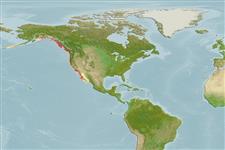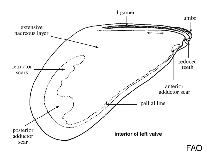Mytilus californianus Conrad, 1837
California mussel| Native range | All suitable habitat | Point map | Year 2050 |

|
| This map was computer-generated and has not yet been reviewed. |
| Mytilus californianus AquaMaps Data sources: GBIF OBIS |
Upload your photos
Google image | No image available for this species;
drawing shows typical species in Mytilidae.
Google image | No image available for this species;
drawing shows typical species in Mytilidae.
Classification / Names Common names | Synonyms | CoL | ITIS | WoRMS
| Mytilida | Mytilidae
Environment: milieu / climate zone / depth range / distribution range Sinh thái học
; Mức độ sâu 0 - 100 m (Ref. 95344), usually 0 - 30 m (Ref. 104320). Temperate; 62°N - 18°N, 180°W - 109°W
Sự phân bố Các nước | Các khu vực của FAO | Các hệ sinh thái | Những lần xuất hiện | Những chỉ dẫn
Eastern Pacific: from Aleutian Islands, Alaska, USA to Baja California and Isla Socorro, Mexico. Subtropical to boreal.
Length at first maturity / Bộ gần gũi / Khối lượng (Trọng lượng) / Age
Maturity: Lm ? range ? - ? cm Max length : 25.5 cm TL con đực/không giới tính; (Ref. 95344); common length : 20.0 cm TL con đực/không giới tính; (Ref. 312)
Short description Hình thái học
Shell with blue, black and irregular groove lines. Often create dense mats. Mats can form habitats for more than 100 other species (Ref. 312).
It has a shell length of 20 cm long (Ref. 312). Found in dense colonies on wharf piles and surf exposed rocks in the mid to high tide zone. Its diet include fine organic detritus, living plankton, especially dinoflagellates; when the water exceeds a certain temperature, often from late May through October, mussels feed on dinoflagellates that make them poisonous for humans to eat (Ref. 312). Very dominant competitor in an intertidal bed. Prefers to settle on other mussels and barnacles, giving it a competitive advantage (Ref. 104225). Predators are ochre star, dogwinkle, and humans (Ref. 312). Occurs from mid to high tide mark (Ref. 312).
Life cycle and mating behavior Chín muồi sinh dục | Sự tái sinh sản | Đẻ trứng | Các trứng | Sự sinh sản | Ấu trùng
Life cycle: Egg develops into the first free-swimming larval stage (trocophore) within 4 to 24 hours, afterwhich it develops into a veliger larvae within 24 to 48 hours. The veliger secretes the first larval shell within 10 to 12 hours, which then develops into a velichoncha larvae which secretes the second larval shell. It further develops into pediveliger, with a characterized foot making it mobile to find a suitable substrate and able to feed. It metamorphoses into a post-larval mussel called plantigrade (Ref. 104799).
Main reference
Các tài liệu tham khảo | Người điều phối | Người cộng tác
Gallivan, G. and J. Danforth. 1999. (Ref. 312)
IUCN Red List Status (Ref. 130435)
CITES status (Ref. 108899)
Not Evaluated
CMS (Ref. 116361)
Not Evaluated
Threat to humans
Human uses
Các nghề cá: Tính thương mại
| FishSource | Biển chung quanh ta
Các công cụ
Thêm thông tin
Các nước
Các khu vực của FAO
Các hệ sinh thái
Những lần xuất hiện
Những chỉ dẫn
Stocks
Sinh thái học
Thức ăn
Các loại thức ăn
Các khu vực của FAO
Các hệ sinh thái
Những lần xuất hiện
Những chỉ dẫn
Stocks
Sinh thái học
Thức ăn
Các loại thức ăn
Tên thường gặp
Các synonym ( Các tên trùng)
Các động vật ăn mồi
Sự tái sinh sản
Chín muồi sinh dục
Đẻ trứng
Sự sinh sản
Các trứng
Egg development
Các synonym ( Các tên trùng)
Các động vật ăn mồi
Sự tái sinh sản
Chín muồi sinh dục
Đẻ trứng
Sự sinh sản
Các trứng
Egg development
Các nguồn internet
BHL | BOLD Systems | CISTI | DiscoverLife | FAO(Publication : search) | Fishipedia | GenBank (genome, nucleotide) | GloBI | Gomexsi | Google Books | Google Scholar | Google | PubMed | Cây Đời sống | Wikipedia (Go, tìm) | Tạp chí Zoological Record
Estimates based on models
Preferred temperature
(Ref. 115969): 8.6 - 14.3, mean 10.1 (based on 140 cells).



